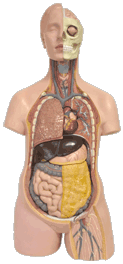At WiseGEEK, we're committed to delivering accurate, trustworthy information. Our expert-authored content is rigorously fact-checked and sourced from credible authorities. Discover how we uphold the highest standards in providing you with reliable knowledge.
What Is the Transversalis Fascia?
The transversalis fascia is a fine sheet of white tissue that lies beneath the transversus abdominus muscle, separating it from the peritoneum, the membrane that lines the abdominal cavity. Like the soft tissue that makes up tendons and ligaments, fascia is largely made up of collagen fibers, and is a membranous layer that surrounds and divides the body’s various organs and tissues. The transversus abdominus is the deepest of the four abdominal muscles. Beneath it are only a few layers of tissue, the outermost of which is the transversalis fascia, separating the muscle wall from the abdominal cavity, which houses the stomach, intestines, and other organs.
Working from the outside in, beneath the skin and fat covering the abdomen are four abdominal muscles: the rectus abdominis, external obliques, internal obliques, and the transversus abdominis. Each is enveloped and separated from the others by its own layer of fascia, known as an aponeurosis, though the individual layers of aponeurosis often blend with one another. The transversus abdominis is layered beneath the internal obliques on either side of the abdomen, with its fibers attaching in the middle to the underside of the rectus abdominis muscle along its midline, the linea alba. Thus a continuous layer or wall of abdominal muscle is formed that extends from one side of the waist to the other.

On the underside of the transversus abdominus is its own aponeurosis, and beneath that is the transversalis fascia. Unlike the aponeurosis, which wraps the muscle itself, the transversalis divides the muscle from the peritoneum. The peritoneum features several layers of its own and is the membrane surrounding and containing the abdominal cavity, which houses the organs of digestion like the stomach and intestines, the accessory organs of digestion like the liver and gallbladder, urinary organs like the kidneys, and immune system organs like the spleen. Immediately behind the transversalis fascia is the outermost layer of the peritoneum, known as the extraperitoneal fascia. Like the fascia of the abdominal muscles, these two layers are fairly continuous.
Above, the transversalis fascia extends to the diaphragm muscle, which spans the underside of the ribcage, and its fibers unite with those of the aponeurosis of the diaphragm. Below, it runs into a similar layer of fascia known as the iliac fascia, a reference to the large ilium bones of the upper pelvis, as well as the pelvic fascia. Just as the abdominal cavity becomes the pelvic cavity as it dips into the interior of the pelvis, the transversalis fascia essentially ends where it reaches the hip bones and blends into the iliac and pelvic fasciae. The lateral or outside fibers of the transversalis fascia extend to the iliac crest, or the top of the ilium bone felt on either side of the hip, while the inside fibers of the fascia continue all the way down to the pubic bone in the central bottom portion of the pelvis.
AS FEATURED ON:
AS FEATURED ON:










Discuss this Article
Post your comments